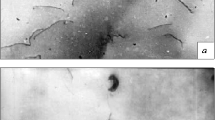Conclusions
-
1.
Heterogeneity of the chemical composition and hardness in micro-and macrovolumes is observed in ingots of molybdenum and tungsten alloys. The large carbide inclusions in the ingots are the result of uneven solidification.
-
2.
Prolonged high-temperature annealing partially removes the chemical heterogeneity in ingots of the molybdenum alloy, leading to solution of the large carbides and improving the plasticity. Annealing of the tungsten alloy equalizes the hardness through the section of the ingot.
Similar content being viewed by others
Literature cited
V. I. Shulepov, “Ductile-brittle transition in molybdenum,” in: Metallurgy and Metal Science of Pure Metals [in Russian], No. VII, Atomizdat, Moscow (1968), p. 51.
V. V. Nikishanov et al., “Effect of heat treatment on structure and some properties of cast tungsten,” in: Metallurgy and Metal Science of Pure Metals [in Russian], No. IX, Atomizdat, Moscow (1971), p. 151.
A. M. Zakharov et al., “Study of Mo−Zr−C system,” Izv. Akad. Nauk SSSR, Metally, No. 6, 204 (1970).
A. M. Zakharov et al., “Ternary systems W−Zr−C and W−Hf−C in tungsten-rich regions,” Izv. Akad. Nauk SSSR, Metally, No. 1, 224 (1974).
A. M. Zakharov et al., “Primary section of Mo−Zr−Ni−C tetrahedron with 0.2% C and temperatures of 1800 and 1200°C,” in: Scientific Transactions of All-Union Scientific-Research and Design Institute of Refractory Metals and Hard Alloys [in Russian], No. 13, Metallurgiya, Moscow (1973), p. 24.
V. N. Kiseleva et al., “Ternary Mo−V−C system,” Izv. Akad. Nauk SSSR, Metally, No. 2, 214 (1974).
B. F. Ormont, Introduction to Physical Chemistry and Crystal Chemistry of Semiconductors [in Russian], Vysshaya Shkola, Moscow (1968).
R. B. Kotel'nikov et al., Ultra High-Melting Elements and Compounds [in Russian], Metallurgiya, Moscow (1969), p. 188.
V. I. Shulepov et al., “Mechanism of carbide precipitation in alloys based on molybdenum and niobium,” Fiz. i Khim. Obrabotki Mat., No. 2, 126 (1972).
Additional information
All-Union Scientific-Research and Design Institute of Refractory Metals and Hard Alloys. Translated from Metallovedenie i Termicheskaya Obrabotka Metallov, No. 11, pp. 7–10, November, 1975.
Rights and permissions
About this article
Cite this article
Parshikov, V.G., Leitman, M.S., Shchukin, A.A. et al. Chemical and structural heterogeneity of ingots of molybdenum and tungsten alloys. Met Sci Heat Treat 17, 912–915 (1975). https://doi.org/10.1007/BF00679376
Issue Date:
DOI: https://doi.org/10.1007/BF00679376




